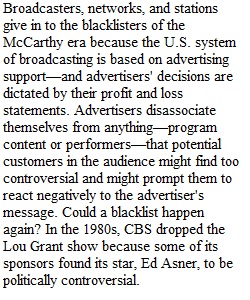


Q CM 103--Prof. --Chapter 5: The Fearful 50s Since chapter five contains a lot of important information, and because there are several questions to answer from this chapter, I am providing you with two weeks to complete your assignment. Please answer ALL of questions posted in Blackboard "Assignments" for weeks 6 & 7 and submit by Sat. by 6PM. Please send me your answers via the designated link (located directly under this post within this "Assignment" section of Blackboard). Onward! GROUP #1 1950 1) Why did broadcasters, networks, and stations give in to the blacklisters of the McCarthy era? --Could a blacklist happen again? 2) Describe the impact of broadcasting the Korean War? 3) What were some of the programs that migrated from radio to TV? 4) How many TV sets were there in the country? 5) What led to delays in the production of color Tvs? --who became the principal manufacturer? 6) When did high definition TV and Pay Per View originate? 7) Describe the Rule of Sevens. 8) What was the ratio of advertising between radio & TV? GROUP #2 1951 9) What were some of the successes of the program See It Now? 10) What impact did TV have on movies? 11) How did TV affect politics? 12) How did TV affect radio? 1952 13) Describe the Sixth Report and Order 14) Did educators affect the assignment of channels to non-commercial stations? 15) What were some of the new political uses of broadcasting? 16) How did newspapers respond to TV? GROUP #3 1953 17) Describe the impact of the I Love Lucy show? --How did Lucy help bring an end to McCarthyism? 18) Describe the development of evening network news? 19) How much were the 1st color TV sets? 20) How did radio adapt to TV? 1954 21) Describe the key factor inn McCarthy s demise? --How did Murrow & Friendly personally become involved in the broadcast? 22) Describe the continuing of blacklisting. 23) How many people bought TV sets? --what was the impact of TV in the family? 24) How much was spent on ads? GROUP #4 1955 25) What were some of the popular shows on TV? 26) Describe the national events that involved TV in politics? 1956 27) What were the 2 happenings that changed the course of broadcasting? 28) How did Eisenhower understand the power of TV? 29) Describe the popularity of quiz shows and westerns. GROUP #5 1957 30) How did McCarthyism live on? 31) Describe some of the programming that emerged during this time? 32) What was payola? 1958 33) Describe the Quiz Show Scandals and its impact on the American public. 34) Describe the controversies over See It Now. GROUP #6 1959 35) How did networks try to improve their images after the quiz-show scandals? 36) What was the kitchen debate? 37) Describe the payola scandal in radio. 38) What is plugola?
View Related Questions